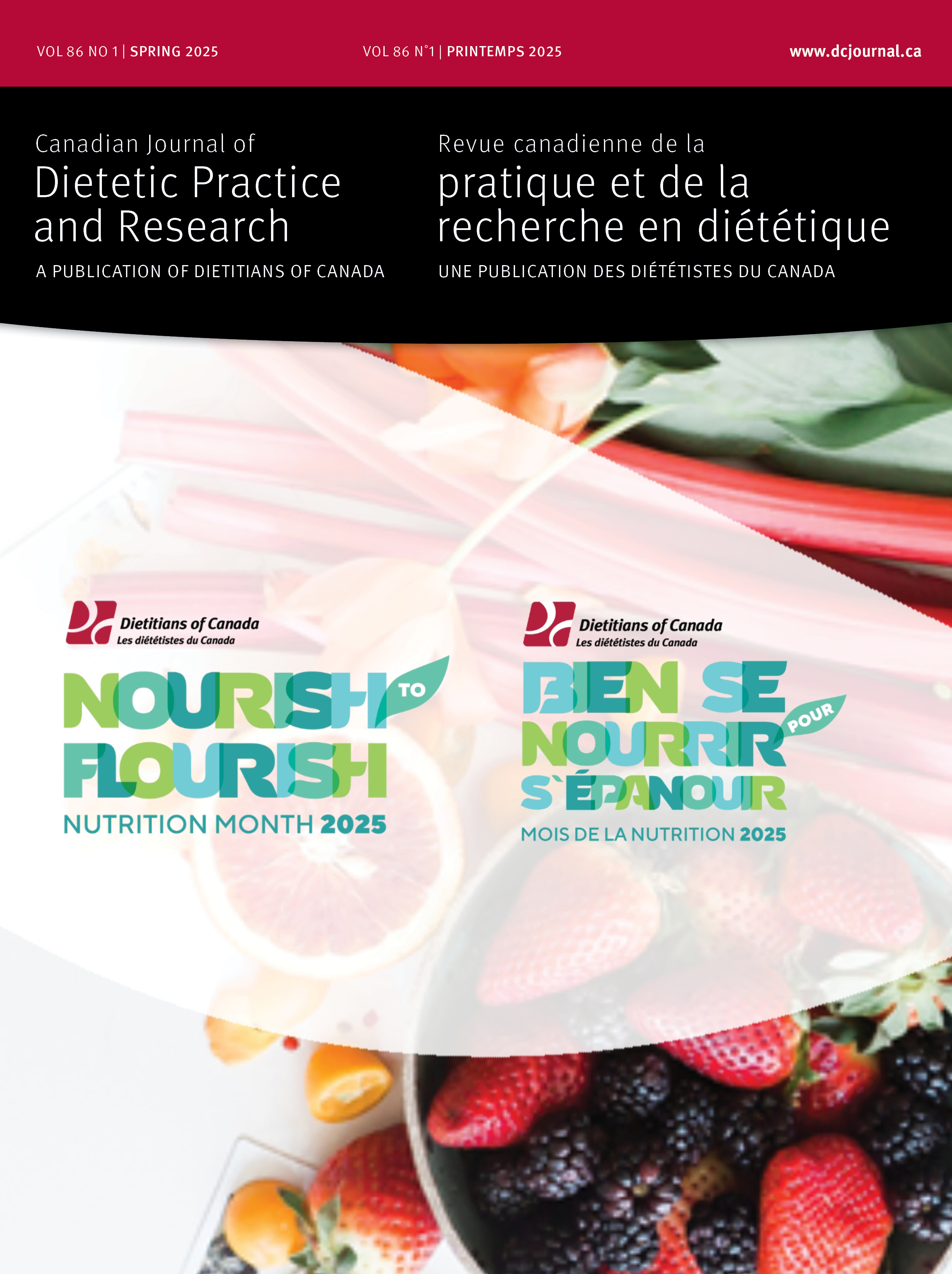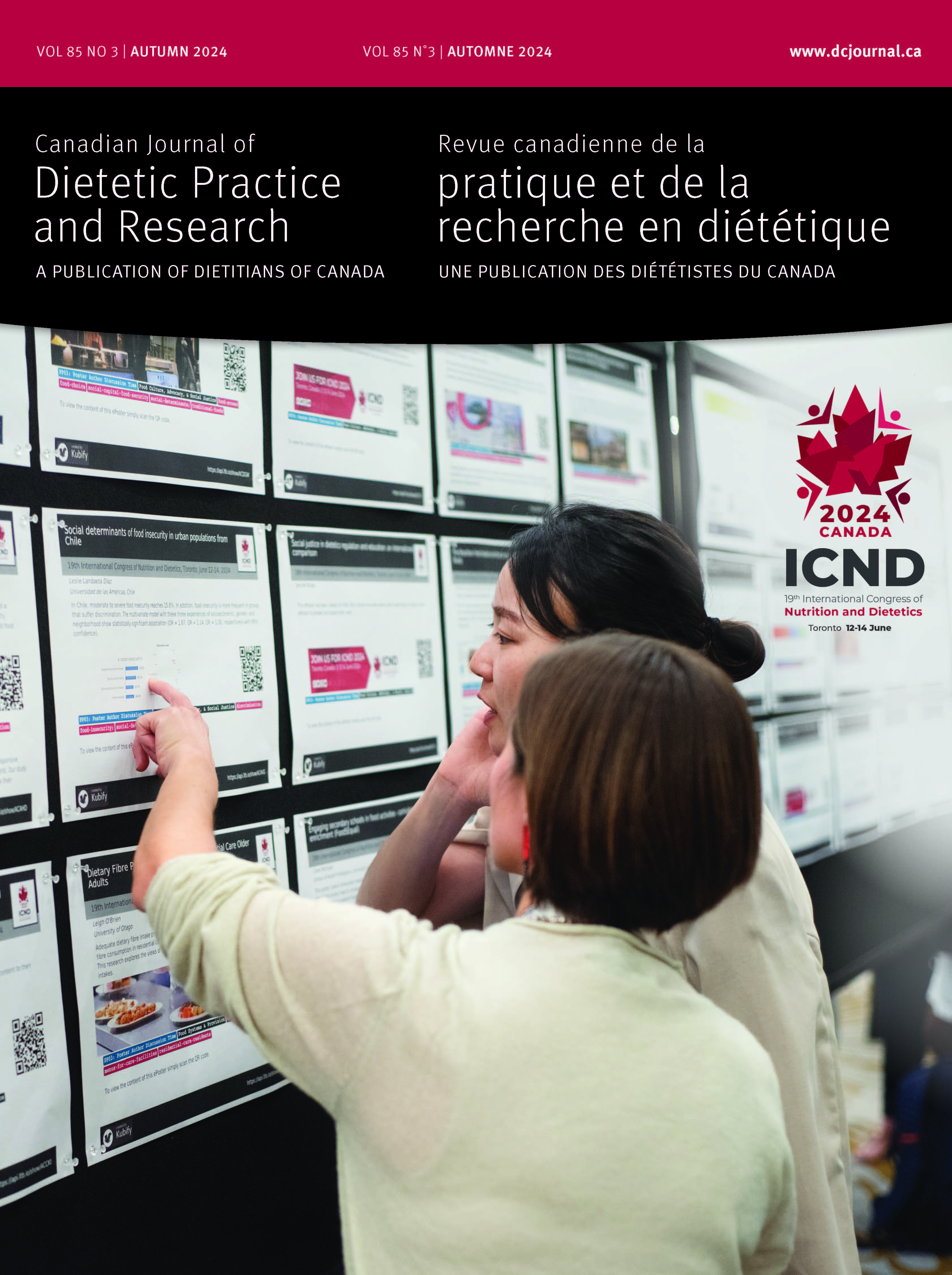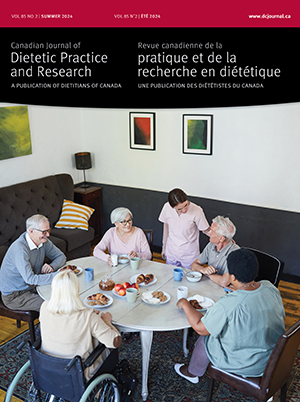Volume 81 • Number 2 • June 2020
Editor’s Message
Letter to the Editor
Research
Purpose: Prenatal multivitamins are recommended in pregnancy. This study assessed food and supplement intakes of folate, vitamin B12 (B12), vitamin D, and choline in pregnant women living in Southern Ontario in comparison with current recommendations.Methods: Women recruited to the Be Healthy in Pregnancy RCT (NCT01693510) completed 3-day diet/supplement records at 12–17 weeks gestation. Intakes of folate, B12, vitamin D, and choline were quantified and compared with recommendations for pregnant women.Results: Folate intake (median (min, max)) was 1963 μg/day dietary folate equivalents (153, 10 846); 90% of women met the Estimated Average Requirement (EAR) but 77% exceeded the Tolerable Upper Intake Level (UL) (n = 232). B12 intake was 12.1 μg/day (0.3, 2336); 96% of women met the EAR with 7% exceeding the EAR 100-fold (n = 232). Vitamin D intake was 564 IU/day (0.0, 11 062); 83% met the EAR, whereas 1.7% exceeded the UL (n = 232). Choline intake was 338 mg/day (120, 1016); only 18% met the Adequate Intake and none exceeded the UL (n = 158).Conclusion: To meet the nutrient requirements of pregnancy many women rely on prenatal vitamins. Reformulating prenatal multivitamin supplements to provide doses of vitamins within recommendations to complement a balanced healthy diet would ensure appropriate micronutrient intakes for pregnant women.
Purpose: A school nutrition policy (SNP) is one promising school-based health promotion strategy to improve the food environments of First Nations children. The aim of this study was to explore First Nations parents’ perceptions of a SNP.Methods: A process evaluation of policy implementation was conducted using a mixed-methods design. Parents (n = 83) completed a 19-question survey to capture their perceptions of the policy. Survey responses informed questions in an 11-question semi-structured interview guide. Transcripts from interviews with parents (n = 10) were analyzed using content analysis to identify barriers and facilitators to policy implementation.Results: Parents were supportive of the SNP and the school’s food programs, which they perceived as helping to address community concerns related to nutrition. However, some parents opposed the restriction of unhealthy foods at school celebrations and fundraisers. In addition, despite being aware of the SNP, parents were unable to demonstrate an understanding of the SNP content. Finally, parents struggled to provide their children with healthy foods to bring to school due to lack of affordable and accessible food in the community.Conclusions: Although SNPs may be well-received in First Nations communities, their implementation must be supported by parent involvement and consideration of wider socioeconomic conditions.
Purpose: The aim of this study was to assess the healthfulness of a sample of campus eateries at 2 time points, 2 years apart.Methods: Five eateries at the University of Waterloo were audited using the Nutrition Environment Measures Survey adapted for university campuses (NEMS-UC) in 2015 and late 2017–early 2018. Based on the availability of healthy options and facilitators of and barriers to healthy eating, possible NEMS-UC scores ranged from −5 to 23 points.Results: Scores were low, ranging from 7 to 14 (mean = 10.8, SD = 2.59) points in 2015 and 7 to 13 (mean = 9.6, SD = 2.19) points in 2017–2018. For all eateries except 1 residence cafeteria, scores at time 2 were the same or lower than scores at time 1. All venues carried whole fruit and vegetable options and lower-fat milks, and most offered whole-wheat options. However, healthier items were often located in low-traffic areas, priced higher than less healthy options, and sometimes limited to prepackaged items. Misleading health messaging was also evident.Conclusions: Increased availability, accessibility, and visibility of healthy offerings is needed to enhance campus food environments and support healthy eating patterns, while barriers such as contradictory messaging should be minimized.
Perspectives in Practice
The type 2 diabetes epidemic is a global crisis threatening the health and economies of many nations. This study aimed to evaluate a prediabetes intervention program designed for rural adults in southwestern Ontario based on the feedback of participants. Rural adults with prediabetes were referred by physicians to an intervention program developed to assist with unique barriers rural adults face related to the built environment and socioeconomic status when adopting a healthy lifestyle. After 6 monthly education sessions offered by a dietitian and a nurse, participants completed a questionnaire to share their program experience. In addition, 6 focus groups consisting of 5–9 participants were conducted to assess program acceptability, feasibility, and practicality. Of 49 enrolled, 35 participants aged 60.8 ± 7.1 (mean ± SD) evaluated the program. Participants reported finding the program to be acceptable, feasible, and practical due to the interactive nature of the sessions, the group setting and the availability of health professionals. This prediabetes lifestyle intervention program was perceived as successfully addressing rural adults’ needs in terms of adopting a healthy lifestyle. Feedback received through program evaluation, which included a participant experience survey and focus groups has helped improve this program and may benefit other prediabetes education intervention programs.
This study aimed to measure the influence of the Chefs in Action program (3 cooking workshops) on cooking skills, nutrition knowledge, and attitudes towards healthy eating in children attending summer day camps and compare it with a single cooking workshop. Groups of children (8–12 years) were randomly assigned to the intervention group (n = 25) or to 1 of 3 comparison groups performing a single workshop (group 1, n = 16; group 2, n = 36; group 3, n = 24). Two dietitians evaluated cooking skills during the workshops. Nutrition knowledge and attitudes towards healthy eating were assessed before and after the intervention. No improvement in cooking skills was observed in the intervention group (P = 0.25). The intervention group’s cooking skills score was significantly higher than comparison group 1 (P < 0.001). Nutrition knowledge was significantly improved in the intervention group and the comparison group 3 (P < 0.0001) but no effect on attitudes towards healthy eating was observed (Pgroup × time = 0.36). In conclusion, the Chefs in Action program positively impacted nutrition knowledge in children. The results also suggest that the type of recipe may influence nutrition knowledge and cooking skills. Further studies are needed to better assess the degree of difficulty required in cooking workshop recipes to improve cooking skills in children.
Report
Purpose: Living Your Best Weight (LYBW) is an outpatient program based on Health at Every Size (HAES) principles for adults interested in managing their weight. The purpose of this pilot study was to determine perceptions of participants and their satisfaction with the LYBW program.Methods: A survey was developed to determine participant satisfaction of the LYBW program. Fifty-six participants who completed the LYBW program from June 2017 to February 2018 were contacted via telephone and invited to participate in the study. Forty-five participants agreed to receive the survey by mail or email.Results: Thirty-four participants completed the survey for a response rate of 61%. The average age of respondents was 52 years. Seventy-nine percent of respondents agreed that the program helped them to focus on health instead of weight. Eighty-two percent agreed that the program helped them respond to internal cues of hunger and fullness, and 94% were satisfied with the program.Conclusion: Participants reported that they were satisfied with the LYBW program and perceived improvements in their health. Future programming may benefit from using a HAES-based approach with adults.
Purpose: In Canada, approximately 45% of hospitalized patients are moderately or severely malnourished upon admission. The protected mealtime policy was designed to address malnutrition in institutions. This pilot study aimed to provide preliminary results examining the effect of this policy on patient energy and protein intake.Methods: A 1-group, pre–post observation design was conducted in a Canadian hospital. Pre- and post-observations included the frequency and type of interruptions, type of interrupter, and patient energy and protein intake at each meal.Results: The average number and length of interruptions decreased, and the average length of mealtime assistance provided to patients (n = 12) increased in the post-observation period. Energy and protein consumption showed a slight increase during the post-observation period.Conclusion: A protected mealtime policy may be an effective policy to address malnutrition among hospitalized Canadian adults. Further studies are warranted in Canada to determine the effects and feasibility of this policy implementation.
Review
Exclusive breastfeeding to 6 months with continued breastfeeding up to 2 years and beyond are well-established infant feeding recommendations based on evidence that breastfeeding has unparalleled maternal and infant health benefits as well as environmental and economic benefits. As with many high-income countries, breastfeeding rates remain suboptimal with only a quarter of Canadian and European infants receiving breast milk exclusively for the first 6 months. Breastfeeding promotion efforts have largely targeted caregivers in the prenatal and postnatal period; however, breastfeeding outcomes have been shown to be associated with broader sociocultural factors. Noncaregivers play an influential role in infant feeding at both an individual level (e.g., cues and input from health care practitioners and caregivers’ social networks; as future parents) as well as a broader population level (sociocultural norms and policy decisions). This paper outlines recent research on breastfeeding knowledge and attitudes of noncaregivers by population subgroup. Positive correlations have been identified between breastfeeding attitudes, infant feeding knowledge, breastfeeding exposure, and breastfeeding intention among different subgroups; however, key knowledge gaps, lack of exposure to breastfeeding, and negative public perceptions of breastfeeding persist. Dietitians can advocate for breastfeeding promotion strategies that consider the role of noncaregivers to address sociocultural norms around breastfeeding.










